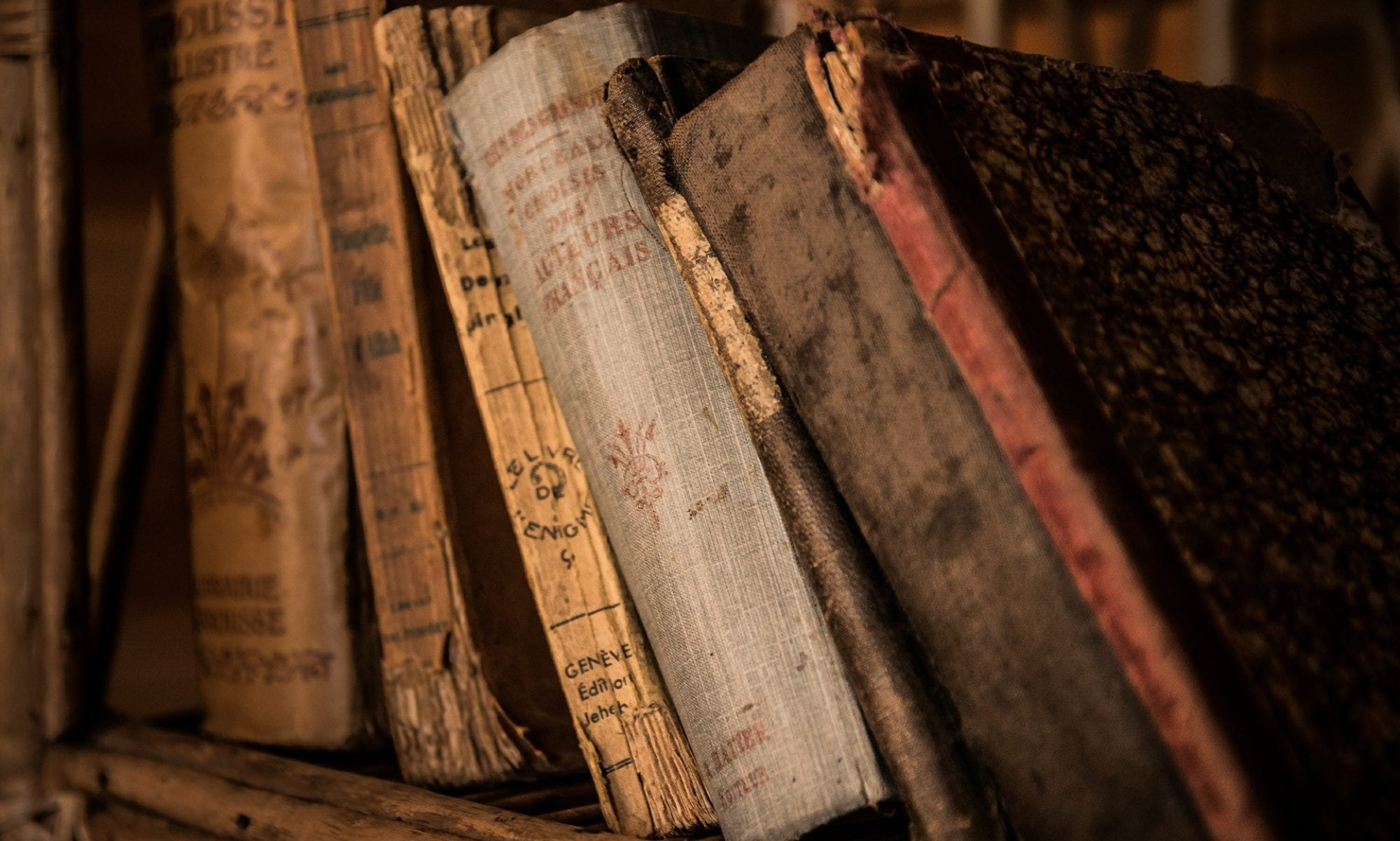| Category | Text |
| Form | Poetry (Lai) |
| Genre | Romance |
| Author | Marie de France |
| Time | Late 12th Century |
| Language | Anglo-Norman French |
| Featured In | Literature and Humanities 1 (YCC1111); Medieval Romance: Magic and the Supernatural (YHU2309); Real and Imagined Animals in Medieval Literature (YHU2330) |
The Lais of Marie de France are a series of twelve lai poems written by Marie de France that are primarily concerned with the ideas of courtly love and chivalric romance. They are highly notable for influencing the development of the medieval romance genre, including the renowned Arthurian romance.
OVERVIEW
Marie’s lais frequently feature two “destined” lovers. True to the chivalric romance conventions, the lais typically depict a nobleman (often a king, or knight) and a beautiful noblewoman (often a queen or an aristocrat’s daughter) who fall in love with each other upon knowing each other’s existence. It is common for one of these lovers to have already been married to another, usually not out of mutual affection but through arrangement. From such a premise, Marie’s lais will go on to focus on the quest for fulfillment of their love, which tends to take the form of illicit affairs and illegitimate children, with the involvement of supernatural and otherworldly elements. One or both lovers may die, and if so, this usually occurs directly or indirectly because of a third party’s jealousy and anger. In these cases, the narrative may shift toward their illegitimate child, who will then seek vengeance and restore the honour of their parents’ love.
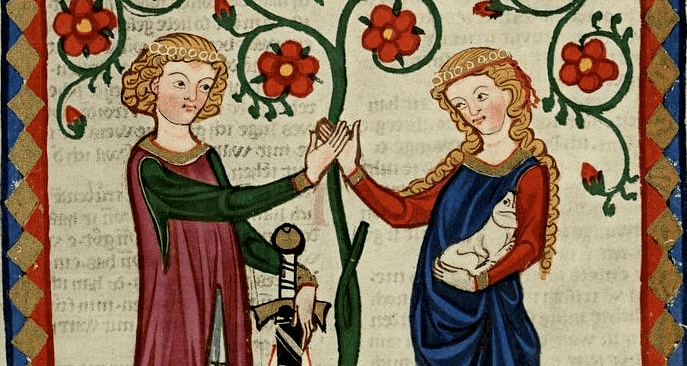
The illicit affairs are almost never depicted negatively by Marie, in fact they seem to be deemed righteous when the love between two parties is mutual and purely stemming from affection. This gives Marie’s lais a rather unique brand of morality that can drive unexpected developments in the narrative, with the possibility for both ideal and tragic endings that provide closures without the modern concept of “poetic justice”.
FORM AND STRUCTURE
Marie’s lais are written in eight-syllable lines with rhyming couplets. The length of the lais vary greatly, ranging from as brief as 118 lines (“Chevrefoil”) to as long as 1184 lines (“Eliduc”).
The twelve lais are ordered in the following manner:
- Guigemar
- Equitan
- Le Fresne
- Bisclavret
- Lanval
- Les Deus Amanz
- Yönec
- Laüstic
- Milun
- Le Chaitivel
- Chevrefoil
- Eliduc
The Harley 978 manuscript is the only manuscript that contains all twelve of the lais, along with Marie’s prologue. While it cannot be said for certain if the order of the lais is of any significance, there has been speculation that they alternate between positive and negative actions (and consequences) that can arise from love, such that the odd lais tend to conclude with good endings while the even ones tend to conclude with bad endings (Ferrante 53).
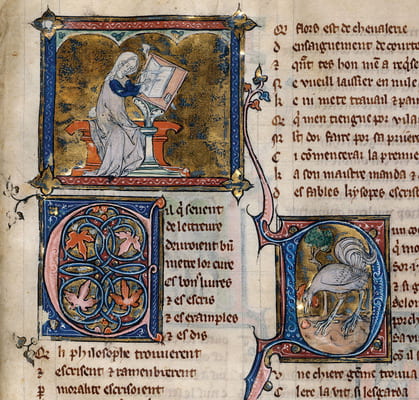
Nonetheless, due to the lack of sufficient information, the abovementioned conjectures remain open to debate. More importantly, such structural concerns about the arrangement of Marie’s lais constitute more of a problem for the modern reader than her audience in the Middle Ages. It is also noteworthy that while Marie’s lais could be read as secular, there had yet to be any real distinction between secular and religious cultures in the late 12th century. Neither are Marie’s works in any way truly against the religious establishment. While the lais may present some form of critique or deviation, they also show a keen interest in exploring the possibilities of fiction, the joy and relief of escapism, and alternate realities. Therefore, Marie’s writing could be seen more as a thought experiment that allows her to assume different vantage points to examine themes that were of interest to her.
“Eliduc” does not seem to fit within this theory, however, though it is possible that Marie wished to end the collection on a good note and with a religious acclamation – a common trend in poetry during that period of time. However, this appears to contradict the world of Marie’s lais, which has been argued to be consistently and firmly secular (Kinoshita and McCracken 51). The case of the uncharacteristically devout ending of “Eliduc” has thus been seen as palinode for the collection’s various radical propositions (Kinoshita and McCracken 91), perhaps to avoid persecution from authorities. Others have read the range of attitudes toward dominant feudal and patriarchal structures across individual lais—some submissive, others subtly subversive or overtly resistant—as ideally suited to twelfth-century reading culture, in which subsequent discussion and debate was a crucial element of the reception of texts (Fisher 209).
GENRE AND LANGUAGE
Prior to the time of Marie’s writing, literary narratives tended to focus either on the quest for martial glory or on the spiritual experience of devotion. By contrast, Marie’s Lais represent a radical transformation of subject matter: while Marie retains some elements of adventure, quest, and journey from epics, she shifts much of the focus to the experience of an idealised, refined, courtly love. The emphasis on inner feeling and self-fulfilment through secular love, to which earlier texts had given little importance, would fundamentally reshape literary representations of human experience.
In addition, Marie’s lais are notable for being written in the vernacular instead of Latin, which would have been the formal language of writing in many areas during that period. In Marie’s prologue to the lais, she claims that she is translating Breton lais that she has heard. In order to keep these stories from being forgotten, she will set them in writing and in verse, at the same time translating them into Old French. The lais thus occupy a liminal position between orality and writing and at the intersection of multiple languages: derived originally from Welsh narratives, preserved in Brittany, then rewritten in England by a French-speaking author for an audience that primarily spoke Anglo-Norman.
Preserving the tone of the Breton lais and making these tales accessible to a wider readership could have been reasons for the use of vernacular French, although whether Marie was merely engaging in translation work remains debatable. It was not uncommon for writers of the time to state that they were translating tales from other sources to claim some form of authority and legitimacy for their work. While none of the “original” lais that Marie claimed to have referenced survived to modern day, it should be noted that the medieval literary culture was at its core, a culture of translation (Kinoshita and McCracken 19). This, alongside the clear artfulness in Marie’s writing, suggest that the lais likely contained much original input from Marie; in fact, she may even have made up the stories herself and invented a fictional origin for them.
CONTEXT
Marie’s lais were written in England around a century after the Norman Conquest of 1066, which resulted in significant social, political, and cultural change. Important implications brought about by the occupation of England include the shift in the language of the elite and an unprecedented contact with the European continent, especially France.
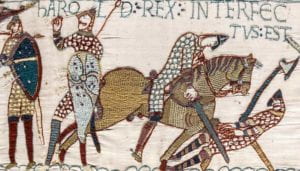
Anglo-Norman French became the dominant language in literature, law, administration, and more, so much so that English nearly disappeared as a distinct language. It did not fully resurface until at least another century later in the form of Middle English, which came to resemble French more than the English of 200 years ago, thus rendering Old English practically unrecognisable to speakers and writers of Middle English.
It is plausible that Marie was based at the court of Henry II and Eleanor of Aquitaine, and this was the kind of French-speaking English aristocracy whom Marie wrote for. Being a French writer situated in England would have allowed her greater access to the highly mobile exchange of cultures and tales incited by the Norman Conquest, more so than her alleged contemporaries such as Chrétien de Troyes who wrote in France. This may explain how Marie could have personally come across the Breton lais and other Celtic sources that inspired her translation and writing. Although Marie was geographically closer to Wales than Brittany, where the mostly oral language of Breton was spoken, the movement of peoples and cultures then was not limited to between the British Isles and continental France, but also within Britain itself. Thus, this is perhaps how Marie’s lais could claim to be of Breton origin yet contain Welsh motifs and settings, and be told through the Anglo-Norman courtly register and perspective, all at the same time.
The question of linguistic and cultural origins is also complicated by the ambiguity of the word “Breton.” While the term now refers specifically to the inhabitants of Brittany in north-western France, in Marie’s time it could also designate the people of ancient Britain now known as the Welsh. (In eliding these related but distinct languages and cultures, the term is perhaps closer to the modern word “Celtic.”) Writing in England, Marie would have been in much closer geographic proximity to Welsh culture, and this is likely what she means by “Breton”. Marie’s relationship to Welsh culture is informed by both the political reality of conquest and the exoticisation of Celtic culture (especially ideas of magic and the Otherworld) by the politically dominant Anglo-Normans.
NOTABLE THEMES

Love
It is evident that love is the key focus in Marie’s lais. Every lai presents a certain situation that a pair of lovers, a parent and child, or lord and vassal, must overcome. True and mutual love is akin to virtue, which is rewarded with happiness. Whereas love that is selfish often yields misfortune. Additionally, love in Marie’s lais comes with implicit rules of polite, courtly interaction; indeed, the true lovers of each lai are always identified as “courteous”, which comes from the Old French word corteis, meaning “courtly”. It is a condition that must be fulfilled before their love can be further strengthened through trials and suffering, which is distinct from classical and other romance depictions of love as an affliction of irrationality that brings about havoc and tragedy (Ashe 246, 261).
Chance
In Marie’s lais, love seems almost whimsical. Unlike the classical concept of “fate”, there is no divine will guiding the narrative and love between two people, and their encounter often occurs by chance. The same can be said about the tokens of love in many of the lais. These tokens usually do not possess any distinctive qualities at all. However, once they are recognised by a character, often entirely coincidentally, they allow separated lovers or kin to rendezvous or reunite with each other. Such ambiguous yet miraculous fulfilment of love in the lais thus make the tokens seem super-charged in significance, as though they are magical.
Loyalty and Justice
Loyalty, or the lack thereof, tends to drive conflict in the narrative, whether it be romantic or non-romantic in nature. For romantic relations, loyalty takes the form of fidelity. Most interestingly, illicit affairs are not considered infidelity within Marie’s lais so long as the love is true. In fact, if a character’s preexisting marital commitment was established not out of love but other agendas, said marriage is not considered the true marriage in the narrative (Ashe 248). Breaking away from such unhappy unions to pursue a true lover is thus encouraged and justified, as seen in lais such as “Yönec” and “Milun”. For non-romantic relations, Marie frequently examines the loyalty between lord and vassal, drawing sympathy for those who are not reciprocated despite being loyal, seen in lais such as “Lanval” and “Eliduc”.
Beauty and Desire
While courage, generosity, and worthiness tend to be the indicators of good character for men in the lais, outward beauty seems to be the indicator and reflection of good character and interiority in women. It is beauty that signals to the men their supposed lover, where the more unparalleled the beauty, the more desirable the woman. In “Lanval”, this idea is taken to the extreme with the fae-like lady from Avalon, as beauty becomes the basis of the legal system that tries Lanval, and the bedrock whereupon the honour of King Arthur and his court rests. Marie does not, however, reduce the women in her lais to mere beautiful objects; rather, they are empowered by their beauty, possessing a degree of agency to influence others and even challenge rigid societal structures.
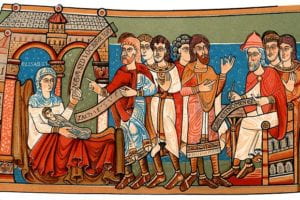
Origins and Names
Although most characters in the lais are not given names, Marie pays a great deal of attention to the names of each lai, some of which are named after characters in the narrative. Nearly every lai comes with an introduction or closing about the various ways it is referred to across different cultures and different languages, such that at times Marie even steers away from the main narrative, devoting a considerable number of lines solely to discuss its naming and what each name identifies. Lais such as “Bisclavret” show the instability and difficulty of precise designation in naming because the same word (“bisclavret”) could refer to a supernatural creature (the werewolf), the name of the character who turns into said creature, the text itself, the concept of turning into such a creature, a story originating from a certain culture, or even the genre of such tales in general. This is further complicated in translation when an alternative title in a different language is presented, for it inevitably carries its own set of connotations that may or may not differ greatly from the original. Marie’s consideration of names and their implications thus undermines the certainty of any definitive categorisation into singular identities, reflecting the shifting and complex nature of linguistic and cultural identity in the setting in which she was writing.
Human / Animal
Marie invites contemplation of what truly constitutes human identity through human / animal transformations in the lais of “Bisclavret” and “Yönec”. Just like the instability of name designation, the characters resist being identified as either properly human or animal. Rather, the lais depict the external form in a state of flux, suggesting humanity to be more of a process and an ongoing transformation, than something intrinsic (Campbell 106). Conditions of humanity include courtly behaviour, belief in God, and in some ways, social inclusion. However, this treatment is notably less applicable to Marie’s female characters, who often undergo a parallel transformation that is less controllable, more exposed, visible, and closer to the classical tradition of depicting physical appearances as manifestations of a character’s inner state (106).
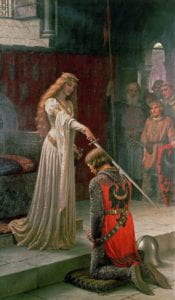
Interiority
Marie’s focus on love, an emotional experience, naturally places more weight in her narrative towards interiority. This is seen from how the lais centre on small, select groups of characters often in settings away from society, from their concerns about privacy and being discreet, and from the amount of detail dedicated to the courtly exchanges between lovers, which stands in stark contrast to the brief and anticlimactic descriptions of martial exploits. By shifting the traditional emphasis of the quest for glory to obtaining the lady’s love and self-fulfilment, Marie promotes celebration of the personal qualities, skills, and nobility of characters without them always having to be kings or saintly martyrs. This is in line with developments in theology and knighthood during the 12th century, which enabled writers (including Marie) to be recognised by their individual artistry instead of solely by the authority of their sources or religious truths (Ashe 243-244). Although the lais do not engage as extensively in the characters’ emotional states as some other romances, their concern with inner human experiences may offer insights on early ideas about individuality.
REFERENCES
Ashe, Laura. “It Is Different with Us: Love, Individuality, and Fiction.” 1000-1350: Conquest and Transformation, special issue of The Oxford English Literary History, vol. 1, no. 5, 2017, pp. 241-291. Oxford Scholarship Online, doi:10.1093/oso/9780199575381.003.0006.
Ferrante, Joan M. “Marie de France.” A New History of French Literature, edited by Denis Hollier, Harvard University Press, 1994, pp. 50-55.
Fisher, Marianne. “Culture, Ethnicity, and Assimilation in Anglo-Norman Britain: The Evidence from Marie de France’s Lais,” Exemplaria 24.3: 195-213.
Gilbert, Dorothy, translator. Marie de France: Poetry. By Marie de France, W. W. Norton & Company, 2015.
Kinoshita, Sharon, and McCracken, Peggy. Marie de France: A Critical Companion, Boydell & Brewer, 2012.
IMAGE CREDITS
[Featured Image & Fig. 2] https://marie-defrance.tumblr.com./
[Fig. 1] https://www.medievalists.net/2015/10/a-medieval-love-letter-and-eat-your-meat/
[Fig. 3] https://www.historic-uk.com/HistoryUK/HistoryofEngland/The-Norman-Conquest/
[Fig. 4] https://en.wikipedia.org/wiki/Courtly_love
[Fig. 5] https://www.historyextra.com/period/medieval/medieval-baby-name-charts-popular-old-fashioned-names-trends-history/
[Fig. 6] https://en.wikipedia.org/wiki/Accolade
CONTRIBUTED BY DR. EMILY DALTON & TOH HONG JIN (’23)
